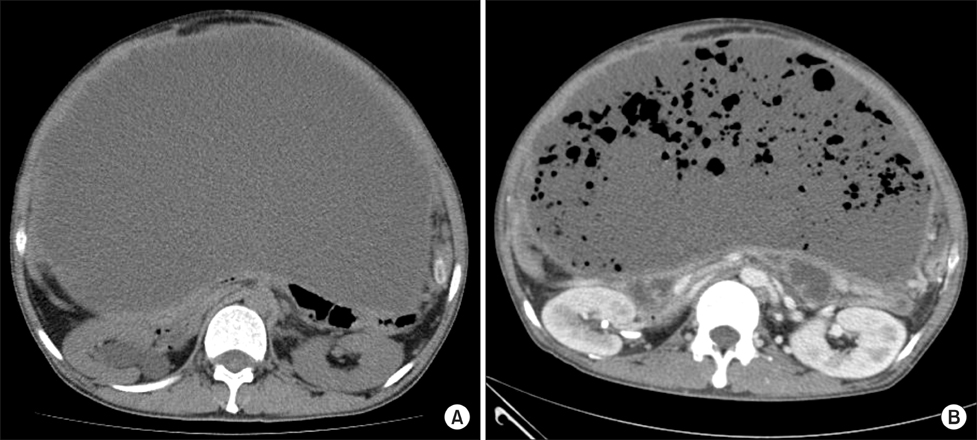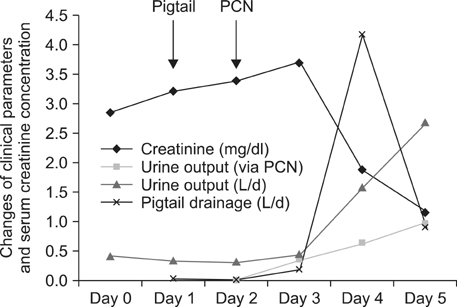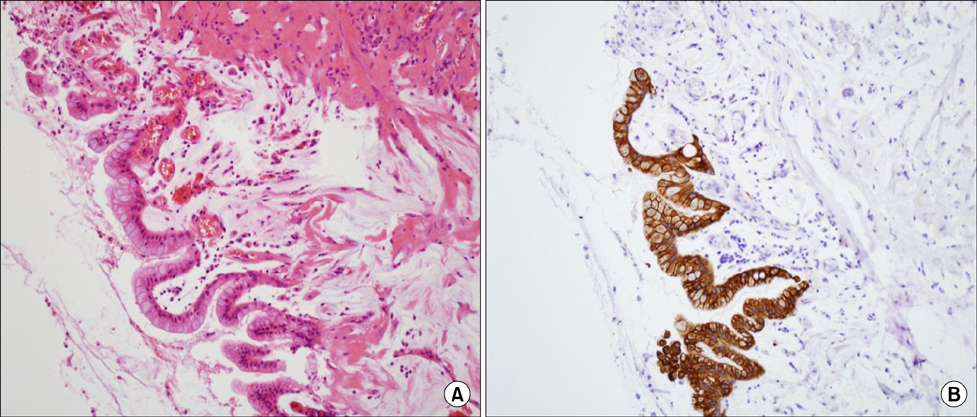Chonnam Med J.
2013 Aug;49(2):87-90. 10.4068/cmj.2013.49.2.87.
Pseudomyxoma Peritonei: A Rare Cause of Oliguric Acute Kidney Injury
- Affiliations
-
- 1Department of Internal Medicine, Korea University Ansan Hospital, Koea University College of Medicine, Ansan, Korea. cdragn@unitel.co.kr
- KMID: 1428268
- DOI: http://doi.org/10.4068/cmj.2013.49.2.87
Abstract
- Pseudomyxoma peritonei is a rare clinical condition that causes the accumulation of mucinous ascites, which gradually results in the compression of intra-abdominal organs. Most published reports of pseudomyxoma peritonei concern the mass effect of the resulting ascites, which presents as abdominal pain or intestinal ileus in severe cases. However, few reports of renal complications of the disease have been published. Here, we present a case of oliguric acute kidney injury caused by external compression by pseudomyxoma peritonei. After decompression with external drainage, the patient's renal function rapidly improved.
MeSH Terms
Figure
Reference
-
1. Moran BJ, Cecil TD. The etiology, clinical presentation, and management of pseudomyxoma peritonei. Surg Oncol Clin N Am. 2003; 12:585–603.
Article2. Smeenk RM, Verwaal VJ, Zoetmulder FA. Pseudomyxoma peritonei. Cancer Treat Rev. 2007; 33:138–145.
Article3. Lee JK, Song SH, Kim I, Lee KH, Kim BG, Kim JW, et al. Retrospective multicenter study of a clinicopathologic analysis of pseudomyxoma peritonei associated with ovarian tumors (KGOG 3005). Int J Gynecol Cancer. 2008; 18:916–920.
Article4. Ioannidis O, Cheva A, Paraskevas G, Papadimitriou N, Konstantara A, Chatzopoulos S, et al. Pseudomyxoma retroperitonei: report of 2 cases and review of the literature. Rev Esp Enferm Dig. 2012; 104:268–275.
Article5. Cauchy F, Lefevre JH, Mourra N, Parc Y, Tiret E, Balladur P. Mucinous cystadenoma of the mesocolon, a rare entity frequently presenting with features of malignity: two case reports and review of the literature. Clin Res Hepatol Gastroenterol. 2012; 36:e12–e16.
Article6. Bellomo R, Ronco C, Kellum JA, Mehta RL, Palevsky P. Acute Dialysis Quality Initiative Workgroup. Acute renal failure - definition, outcome measures, animal models, fluid therapy and information technology needs: the Second International Consensus Conference of the Acute Dialysis Quality Initiative (ADQI) Group. Crit Care. 2004; 8:R204–R212.7. Mukherjee A, Parvaiz A, Cecil TD, Moran BJ. Pseudomyxoma peritonei usually originates from the appendix: a review of the evidence. Eur J Gynaecol Oncol. 2004; 25:411–414.8. Harman PK, Kron IL, McLachlan HD, Freedlender AE, Nolan SP. Elevated intra-abdominal pressure and renal function. Ann Surg. 1982; 196:594–597.
Article9. Yaqoob M, Fahal IH, Finn R. Obstructive nephropathy due to pseudomyxoma peritonei and its management by cystic obliteration and urinary diversion. Nephrol Dial Transplant. 1991; 6:60–61.
Article10. Moran B, Baratti D, Yan TD, Kusamura S, Deraco M. Consensus statement on the loco-regional treatment of appendiceal mucinous neoplasms with peritoneal dissemination (pseudomyxoma peritonei). J Surg Oncol. 2008; 98:277–282.
Article
- Full Text Links
- Actions
-
Cited
- CITED
-
- Close
- Share
- Similar articles
-
- A Case of Pseudomyxoma Peritonei
- A Case of Pseudomyxoma Peritonei with Primary Borderline Mucinous Tumors of the Ovary and Appendix
- A case of the pseudomyxoma peritonei
- A Case of Pseudomyxoma Peritonei Associated with Borderline Mucinous Tumor of Both Ovaries and Appendix
- A Case of Pseudomyxoma Peritonei




